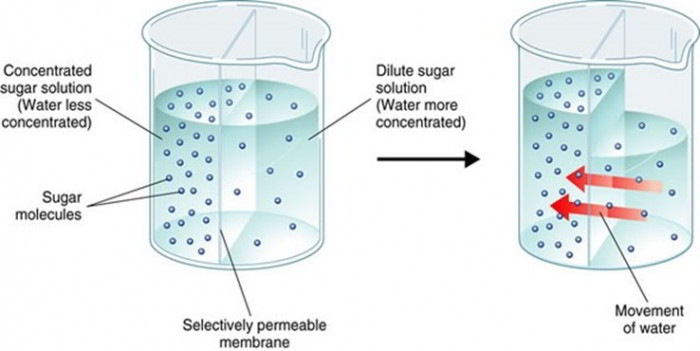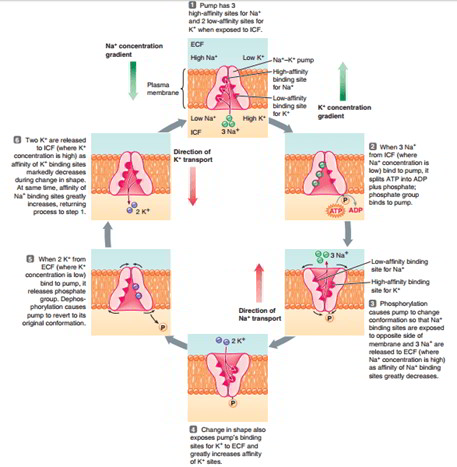A cell keeps its homeostasis mainly by managing the movement of substances across the selectively permeable plasma membrane. Some substances pass across the plasma membrane by passive transport, which needs no expense of ATP by the cell. Other substances move across the plasma membrane by active transport, which needs the cell to use up ATP.
Types of Transport Across The Plasma Membrane
Type | Mechanism |
|---|---|
| Passive Transport | The transport that needs no expense of ATP by the cell |
| Basic diffusion | Transport of lipid-soluble substances across plasma membrane along their concentration gradient without the assistance of membrane proteins |
| Channel-mediated | Channel-mediated |
| diffusion | Transport of water-soluble substances across the plasma membrane along their concentration gradien' through channel proteins |
| Carrier-mediated | Carrier-mediated |
| Facilitated diffusion | Movement of water-soluble substances across the plasma membrane along their concentration gradient using carrier proteins that help with transport by altering their shape |
| Osmosis | Movement of water across the plasma membrane in the direction of the more extremely focused impenetrable solutes, either by crossing the plasma membrane straight or by moving through a channel protein |
| Active Transport | The transport that needs the expense of ATP by the cell |
| Carrier-mediated active transport | Movement of little substances across the plasma membrane, by carrier proteins (pumps), typically opposite to the concentration gradient |
| Exocytosis | Movement of strong particles from the cell, by combining the secretory blister with the plasma membrane and clearing its contents into extracellular space |
| Endocytosis | Movement of strong particles and beads of liquid into the cell, by swallowing up the substances with the plasma membrane and forming a vesicle including the carried substance in the intracellular space |
| Pinocytosis | The process by which cells swallow up beads of extracellular fluid |
| Phagocytosis | The process by which cells swallow up strong particles |
Passive Transport
There are 3 significant types of passive transport: diffusion, osmosis, and filtration.
Diffusion
Diffusion is the net movement of substances from an area of greater concentration to an area of lower concentration. Hence, the movement of substances is along a concentration gradient, the distinction in between the concentrations of the particular substances in the 2 locations. Diffusion happens in both gases and liquids and arise from the continuous, random movement of substances Diffusion is not a living process; it happens in both living and non-living systems.
For instance, if a pellet of a water-soluble color is put in a beaker of water, the color molecules will gradually diffuse from the pellet (the area of greater concentration) throughout the water (the area of lower concentration) up until the color molecules are equally dispersed, that is, at balance. In a similar method, the molecules of cologne, on the skin of a trainee sitting in the corner of a class, will spread out across the class.
Lipid-soluble molecules, such as lipids, oxygen, co2, and lipid-soluble vitamins, have the ability to diffuse across a plasma membrane along concentration gradients since they can dissolve in the phospholipid molecules of the plasma membrane. This type of diffusion is called basic diffusion since it does not need the assistance of the membrane proteins For instance, the exchange of respiratory gases happens by basic diffusion. Air in the lungs has a higher concentration of oxygen and a lower concentration of co2 than the blood does. For that reason, oxygen diffuses from air in the lungs into the blood, and co2 diffuses from the blood into the air in the lungs.
Water-soluble molecules, such as glucose, amino acids, water-soluble vitamins, and ions, can not be carried by basic diffusion since they can not dissolve in the phospholipids. Some water-soluble substances are carried through channel proteins Channel proteins are tunnel-shaped membrane proteins that produce pores or openings, which enable particular substances to pass across the plasma membrane along their concentration gradient.
Channel proteins are usually selective; this indicates they have the tendency to enable restricted substances to pass across based primarily on size and charge. This type of transport is called channel-mediated diffusion. Other water-soluble substances usage carrier proteins Carrier proteins are membrane proteins that physically bind to and transport particular substances across the plasma membrane; this indicates that a person type of carrier protein binds just one type of substance This type of transport is called carrier-moderated diffusion. Carrier-mediated diffusion is a type of facilitated transport, which utilises carrier proteins to help with the movement of substances across the plasma membrane. Carrier-mediated active transport, another type of facilitated transport.
Osmosis
The passive movement of water across a selectively permeable membrane is called osmosis. Water molecules move across the plasma membrane from an area of greater water concentration (lower solute concentration) into an area of lower water concentration (greater solute concentration), either by crossing the plasma membrane straight or by moving through a channelprotein Osmosis plays an essential role in the functions of the cells and the entire body. Water molecules are the dominant components of cells and act as the solvent of the other chemicals. Likewise, the movement of water molecules into and from the cells has the capability to considerably impact the volume of cells and the concentration of the chemicals within them.
The beaker is divided into 2 compartments (A and B) by a selectively permeable membrane that permits water molecules however not sugar molecules to pass across it. Since the greater concentration of water remains in compartment A, water moves from compartment A into compartment B. Sugar molecules can not pass across the membrane, so water molecules from compartment A continue to move into compartment B, triggering the volume of the solution in compartment B to increase as the volume of water in compartment A reduces.
Like compartment B in figure, living cells likewise consist of numerous substances to which the plasma membrane is impenetrable. For that reason, any modification in the concentration of water across the plasma membrane will result in net gain or loss of water by the cell and a modification in cell volume and shape. The capability of a solution to impact the tone or shape of living cells by changing the cells’ water material is called tonicity.
A solution with a lower concentration of solutes (greater concentration of water) than the cell is called a hypotonic solution A cell put in this solution will get water and boost in size, which might ultimately cause burst of the cell. A solution with a greater concentration of solutes (lower concentration of water) than the cell is referred to as a hypertonic solution A cell put in this solution will lose water and diminish, which might cause cell death A solution that has the exact same concentration of solutes (exact same concentration of water) as the cell is an is otonic solution When surrounded by this solution, a cell shows no net gain or loss of water and no modification in volume.
Active Transport
Unlike passive transport, active transport needs the cell to use up energy (ATP) to move substances across a plasma membrane. There are 3 fundamental active transport mechanisms: carrier-moderated active transport, endocytosis, and exocytosis.
Carrier-Mediated Active Transport
Carrier-mediated active transport utilizes carrier proteins to move substances across the plasma membrane, typically opposite to (versus) their concentration gradient, utilizing energy offered by ATP. Figure above shows how a carrier protein, called the sodium-potassium pump (Na +/ K + pump), moves 3 salt ions and 2 potassium ions versus their concentration gradients. The action of this pump triggers a salt gradient from outdoors to inside the cell and a potassium gradient from the within the cell to the exterior. The gradients developed are extremely crucial in the total performance of the whole human body.
Endocytosis and Exocytosis
Materials that are too big to be carried by channel or carrier proteins should go into and leave a cell by completely various mechanisms Endocytosis is a process that utilizes the plasma membrane to swallow up, or internalize, strong particles and beads of liquid.
During endocytosis, the plasma membrane streams around the substance to be swallowed up, forms a covering blister around the substance, and re-forms the plasma membrane outside to the blister so that the blister and substance are brought inside the cell. There are 2 types of endocytosis: pinocytosis and phagocytosis. Pinocytosis is the engulfment of little beads of extracellular fluid Phagocytosis is the engulfment of strong particles. Lots of types of cells utilize these processes, however phagocytosis is particularly crucial for particular white blood cells that swallow up and damage bacteria as a defence versus disease.
Exocytosis is the reverse of endocytosis, because it is utilized to get rid of big substances from cells A secretory blister including the substance types within the cell. It then moves to the plasma membrane, merges with it, and clears its contents beyond the cell.
Other Transport Processes
Up until now we have actually thought about transport across the cell membrane, i.e. movement of substances in between the ICF and the ECF through the cell membrane. In addition to this, there are numerous scenarios in the body where transport of substances happens through the epithelia and the capillary endothelial cell membrane. A few of these processes talked about briefly are: Transport across epithelia and Ultrafiltration.
Transport across Epithelia
Transport across epithelia includes movement of the substances from one side of the epithelium to the other. The transepithelial transport happens in body cavities lined by constant sheet of cells, such as in gastrointestinal tract, renal tubules, pulmonary respiratory tracts and other structures For transepithelial transport to happen, the cells have to be bound by tight junctions and have various ion channels and transport protein in various parts of their membrane.
Ultrafiltration
When a solution of protein and salt is separated from plain water or a less focused salt solution by a membrane permeable to salt and water and not to the protein, there will be a net movement of water on the protein side by diffusion and a movement of salt away from the protein side. This process is called dialysis. Ultrafiltration describes incident of dialysis under hydrostatic pressure Ultrafiltration is happening at the capillary level in the body. The capillary blood is under hydrostatic pressure The pressure is 35 mm Hg near the arteriolar end and slowly decreases to 12 mm Hg near the venous end of the capillary Through the capillaries there happens ultrafiltration of all the constituents of the plasma other than the proteins into the interstitial areas. Ultrafiltration plays crucial role in the formation of body fluids.



 (49 votes, average: 4.73 out of 5)
(49 votes, average: 4.73 out of 5)